
Astyanax is a genus of freshwater fish in the family Characidae of the order Characiformes. Some of these fish, like many of their relatives, are kept as aquarium pets and known collectively as tetras. With around 150 described species and new ones being described yearly, this genus is among the largest of the entire order; Hyphessobrycon also has more than 145 species and which one is larger at any one time depends on whether more species have been recently described in one or the other. The blind and colorless cave tetra of Mexico is a famous member of the genus, but its taxonomic position is disputed: Some recognize it as part of the Mexican tetra and this is supported by phylogenetic evidence, but others recognize the cave form as a separate species, A. jordani.

Pompanos are marine fish in the genus Trachinotus in the family Carangidae. Pompano may also refer to various other, similarly shaped members of the Carangidae, or the order Perciformes. Their appearance is of deep-bodied fishes, exhibiting strong lateral compression, with a rounded face and pronounced curve to the anterior portion of their dorsal profile. Their ventral profile is noticeably less curved by comparison, while their anterior profile is straight-edged, tapering sharply to a narrow caudal peduncle. Their dorsal and anal fins are typically sickle-shaped, with very long anterior rays and a succession of much shorter rays behind, with a similarly long & curved, deeply forked tail which has a narrow base. They are typically overall silvery in color, sometimes with dark or yellowish fins, and one or a few black markings on the side of their body. They are toothless and are relatively large fish, up to about 1.2 m (3.9 ft) long, although most species reach no more than half or two-thirds of that size. They are found worldwide in warmer seas, sometimes also entering brackish waters.

The mojarras are a family, Gerreidae, of fish in the order Perciformes. The family includes about 53 species found worldwide in tropical and warm temperate regions. They mostly inhabit coastal salt and brackish waters, although some occur in fresh water.

Thorichthys is a genus of cichlid fish that is native to the Atlantic slope of Middle America, ranging from southern Veracruz and the Yucatán Peninsula in Mexico, to Guatemala and Honduras, with introduced populations in a few other countries. They tend to inhabit moderately-flowing to standing water such as rivers, streams, lakes, ditches and lagoons, and they are primarily freshwater fish, although T. helleri and T. meeki may occur in slightly brackish habitats.
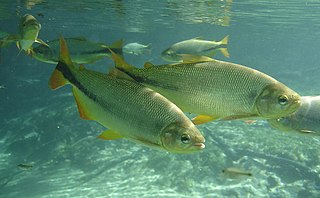
Brycon is a genus of fish in the family Bryconidae and order Characiformes found in freshwater habitats in Central and South America, ranging from southern Mexico to northern Argentina. Despite not being closely related to true trout, they are sometimes called South American trout. Members of the genus may be referred to by a number of other different common names in various languages. They reach a maximum length of 11.9–79.5 cm (4.7–31.3 in) depending on the species involved. Some species perform seasonal breeding migrations.
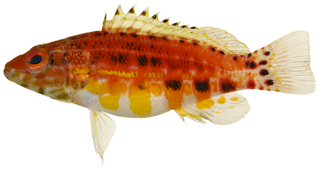
Serranus is a genus of fish in the family Serranidae. It is one of five genera known commonly as the "Atlantic dwarf sea basses". These fish are hermaphrodites, each individual possessing functional male and female reproductive tissues. When a pair spawns, one fish acts as a male and the other acts as a female.
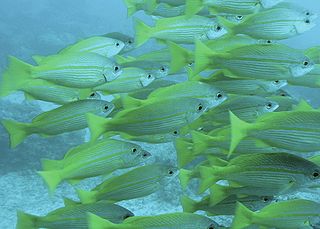
Lutjanus is a genus of marine ray-finned fish, snappers belonging to the family Lutjanidae. They are found in the Atlantic, Indian, and Pacific Oceans. They are predatory fish usually found in tropical and subtropical reefs, and mangrove forests. This genus also includes two species that only occur in fresh and brackish waters.

Cynoscion is a genus of marine ray-finned fishes belonging to the family, Sciaenidae, the drums and croakers. These fishes are found off the coasts of North and South America in the western Atlantic and eastern Pacific Oceans. Many fishes in this genus have been given the common name weakfish.

Parequula melbournensis, the silverbelly, Melbourne silver biddy or silver biddy, is a species of ray-finned fish in the family Garreidae, the mojarras. The species was first described by Francis de Laporte de Castelnau in 1872. It is the only member of the monotypic genus Parequula erected by Franz Steindachner in 1879. It is native to the coastal waters of southern Australia at depths from 3 to 100 m. This species can reach 22 cm (8.7 in) in total length.

Paraclinus is a genus of labrisomid blennies native to eastern Pacific Ocean and the western Atlantic Ocean.

Diapterus is a genus of ray-finned fish in the family Gerreidae, the mojarras. They are native to the Atlantic and Pacific coasts of the Americas.
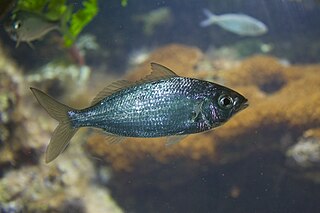
Eucinostomus is a genus of ray-finned fish in the family Gerreidae (mojarras). They are native to the Atlantic and Pacific coasts of the Americas.

Gerres is a genus of mojarras found mostly in coastal regions from the eastern Atlantic Ocean through the Indian Ocean to the western Pacific. A single species, G. simillimus, is from the East Pacific. They mainly inhabit salt and brackish waters, but will enter fresh water. At least one species, Gerres cinereus, displays an ability akin to gyroscopic stability, allowing it to remain in a remarkably static spatial position relative to the water flowing around it.

Pomadasys is a genus of grunts native to the waters of the eastern Atlantic Ocean and through the Indian Ocean to the Pacific coast of the Americas. The name of this genus is a compound of poma meaning "lid" or "covering" and dasys meaning "rough", a reference to the serrated preopercle.
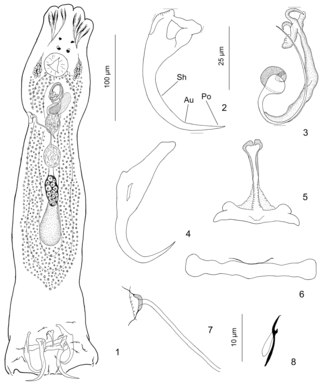
Aristocleidus is a genus of monogeneans erected by Justus F. Mueller in 1936. The genus has been revised by Delane C. Kritsky and Edgar F. Mendoza–Franco in 2008. The amended generic diagnosis is: species with gonads overlapping, ventral anchors with deeply incised base forming deep and superficial roots, a coiled tube of the male copulatory organ in a clockwise orientation, and haptoral hooks with upright acute thumb, slender shank comprising one subunit and FH loop.
José Luis Castro Aguirre was a Mexican ichthyologist. He was a founding member of the Mexican Ichthyological Society and a member of the National System of Investigators who produced around 150 publications, focusing chiefly on the taxonomy, ecology, and biogeography of the fishes of Mexico. His 1978 book Catálogo sistemático de los peces marinos que penetran en aguas continentales de México, con aspectos zoogeográficos y ecológicos was the first catalog of estuarine fishes of Mexico. Born in Mexico City, he attended the National School of Biological Sciences at the National Polytechnic Institute (ENCB-IPN) earning a master's degree in 1974 and a PhD in 1986. He worked at the National Fisheries Institute and the Food and Agriculture Organization in the 1960s, and later was professor and researcher at the ENCB-IPN, Universidad Autónoma Metropolitana, the Interdisciplinary Center of Marine Science and Northeast Center of Biological Research. He described around a dozen fish species, including several species of shark. A book of research papers in his honor was produced in 2012, and he was posthumously commemorated in the names of the fish species Hypoplectrus castroaguirrei and Eugerres castroaguirrei.

Haemulinae is a subfamily of the Haemulidae and consists of the genera of that family which are regarded as being of New World origin, although they are now widespread. The subfamily is distinguished from the Plectorhynchinae by having a short dorsal fin which contains 13-16 soft rays, as opposed to the long dorsal fin with 17-26 soft rays of the subfamily Plectorhynchinae.

Diapterus auratus, the Irish mojarra or Irish pompano, is a species of ray-finned fish from the family Gerreidae, the mojarras. Other common names for this species are the broad shad, silver perch and muttonfish. It is found in the warmer waters of the western Atlantic Ocean.

Rhonciscus is a genus of marine ray-finned fish, grunts belonging to the family Haemulidae. The species within the genus are found in the eastern Pacific and western Atlantic Ocean. It is not yet recognised by Fishbase but is by the Catalog of Fishes.
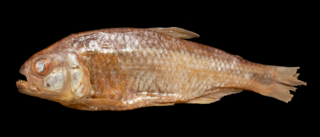
Astyanax brevimanus, sometimes referred to as the Quiché tetra, is a small species of freshwater fish native to various locales in Guatemala. Its native range is somewhat restricted, but it is a populous and adaptable species, so there is no risk of it going extinct anytime soon. It is unknown what A. brevimanus eats, or what specific habitats it prefers; current information is largely in the form of physical descriptions, general areas of occurrence, and hypotheses regarding relationships to congeners. Its silvery scales, indistinct humeral (shoulder) spot, and dark caudal-peduncle spot are features not unusual in species of Astyanax.

















